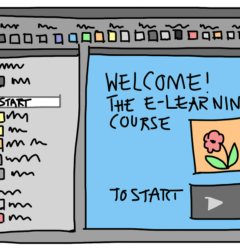Why E-Learning Resonates With Working Professionals
20 Jun

Table of Contents
ToggleHow e-Learning is making working professionals’ life easier
The average full-time American employee works 40–50 hours a week, leaving very little time for family, vacation, and even furthering education. According to Maryville University, 58 percent of all students hold either a part-time or full-time job while obtaining a higher education. Whether you look at full degree programs or one-time online e-courses, education is changing for working professionals around the world.
These days colleges are just as likely to enroll parents, full-time or part-time employees, or members of the armed forces as it is to have recent high school graduates. It is no secret: The face of the American student is changing. Not only are the populations of universities getting more diverse, but they are also expanding their reach far beyond brick-and-mortar classrooms, embracing e-learning and blended learning.
Online education options are increasing as the years of technological evolution tick on. With those pursuing educational opportunities in one form or another, more individuals are making the decision to pursue a degree on their own terms.
Why Are Workers Going Back to School?
There are plenty of reasons for an individual to pursue a greater education beyond what they currently have. Most adults say their reasons for going back to college include the desire to provide a better life for their family. Some are individuals who are in a transitional phase of their life — like after a divorce — and may need to increase their income or who want a simple lifestyle change.
More and more companies are now requiring advanced degrees when hiring new workers. A survey found that almost one-third of employers are increasing the educational requirements for new hires. The same survey found that over a quarter of companies are recruiting individuals with master’s degrees for positions that previously only required a bachelor’s.
Older workers are seeing e-learning and flexible course options as a way to better their lifestyle later in their life. A large number of retirees find themselves leaving the workforce earlier than they anticipated. A survey by PNC Financial Services found that, among retirees aged 70 or older, 58 percent retired before they planned for it. Some cases, such as plant closures and jobs replaced by artificial intelligence, are forcing older individuals to develop new skills or expertise they may not have to launch a second career or to even pivot their current career.
How E-Learning Is Changing Education for Working Professionals
The introduction of online education has changed the way individuals are learning across the world. Not only is it helping working professionals gain access to full degree programs or specific courses, but it has also allowed access to education for those who previously didn’t have any. Here are five ways e-learning benefits modern-day working professionals:
1. Access:
Online learning has given more access to those wanting to expand their skill set, allowing universities and professors into homes through computers. This gives working individuals the opportunity to access their education when it is convenient and possible for them. E-learning is an effective approach to tackling the lack of education in some countries and rural areas.
Realizing the significance of education and e-learning, the Ministry of Human Resources and Development in India has uploaded lectures to be easily accessible by students anytime or anywhere. This just goes to show how far education has come. While those in rural areas now have access to e-learning, business workers in metropolitan cities have the same access to education.
2. Personalized Learning:
Alternative educational opportunities options like e-learning allow for a more personalized experience to the school. Students have the ability to choose what they want to learn and when — making it friendly for the modern-day worker. Allowing students to set their own goals and choose a preferred learning method leads to a better outcome for students.
Unlike traditional classroom settings, professors and teachers are able to track your progress far easier with e-learning and the technology that has come with it. Programs allow instructors to determine a student’s challenges and roadblocks more easily, offering help when needed. Personalized learning puts the success of the student at the forefront of goals.
3. Learning Flexibility:
E-learning allows for a more flexible schedule when it comes to education, making it far easier for individuals to work towards a degree or increase their skill set while maintaining jobs and supporting their families simultaneously.
This alternative education option allows a worker to complete course work when they have time. Often offering little time restrictions, e-learning allows students to listen to lectures and produce work when they feel most productive or when they have time.
4. Academic Collaboration:
Online learning helps promote academic collaboration between students and teachers. One of the main concerns to e-learning that was expressed when it was first introduced was that there would be a lack of collaboration between students, and the truth is that was wrong.
This type of educational space allows students to communicate with each other more easily than before. Students work together to expand their knowledge base in particular subjects or skills. The collaborative learning idea is based on the principle that each student can enrich the learning experience of others, benefiting from one another’s strengths.
5. Affordable
E-learning offers a sense of affordability that isn’t found with traditional education systems. Online platforms allow professors and professionals to engage with a larger, more relevant audience for less overhead costs. This decreased cost is then passed on to the students.
This education alternative allows modern-day working professionals the opportunity to add to their skill set without increasing their own overhead costs, eliminating the need to move, leave a job, etc. to pursue further education.
Conclusion
Through certificate programs, degree curriculums, one-time workshops, or webinar engagement, e-learning is expanding the reach of modern education to working professionals around the world — allowing students to reach their academic goals on their own time. The truth is, time is not going to slow down, and the world around us is only going to continue getting more educated. E-learning allows working professionals to bridge the knowledge gap without it taking a huge toll on their already established lives.
This is a guest post for zipBoard’s blog by Avery Phillips.
If your team is looking to implement new interactive tools for designing interesting learning experiences, check out zipBoard to coordinate the design and development during e-Learning reviews.
Faster e-learning course development
Request a personalized demo to make your eLearning QA process even more efficient with our help!
Book a DemoRelated Post
Recent Posts
- Best Practices for Efficient Document Reviews and Collaboration December 18, 2025
- MEP Document Management: How to Streamline Reviews & Avoid Rework October 3, 2025
- What Is Online Proofing Software? And Why Content Review Breaks Without It July 11, 2025
- How Laerdal Medical Cut eLearning Review Time by 50% with zipBoard’s Visual Review Tool July 9, 2025
- Why Your Team Needs a Content Feedback System (Not Just Comments in Docs) May 28, 2025
©️ Copyright 2025 zipBoard Tech. All rights reserved.


